Pamiat Azova (1886)
The old sailing cruiser of the Tsar:
Several ships in WW1 had far past their prime but were still active, due to the tremendous losses of 1905. The Pamiat Azova (‘Memory of Azov’) was one of them, kept in service by default of new replacements. She was one of these transitional long range, mixed protected cruisers made for distant stations, rather than in a battle line. The very first of these large cruisers considered in Russia and abroad as capital ships, was the Minin (1869), General Admiral class (1873), considered as a capital ship. Vladimir Monomakh (1882), Dmitri Donskoy (1883), Admiral Nakhimov (1885), and the current cruiser were either protected or armoured cruisers.
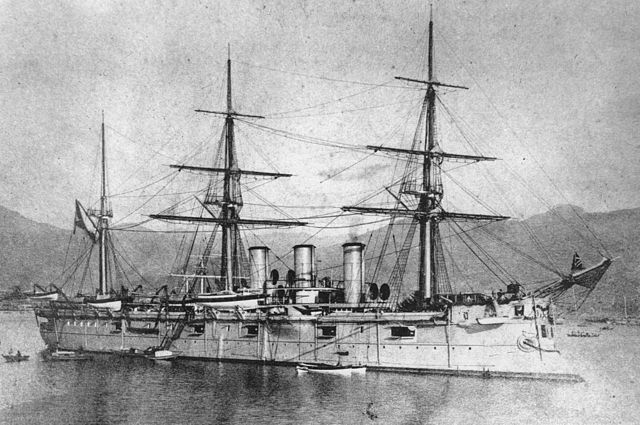
Pamiat Azova as repained in Asia in light greyish-pink hue
The Azova is important in this lineage as it preceded the Rurik, the fastest large cruiser afloat in 1892, with a tonnage approaching 11,000 tonnes fully loaded. More so, her successors, the Gromoboi and Russia trigerred a response of the Royal Navy in the shape of the massive Powerful class. These cruisers created quite a stir in the west, but proceeded from the Pamiat Azova. The truth was she was smaller by tonnage than the 8,500 tonnes turret-ship Admiral Nakhimov, much better protected.
Azova/Azowa was named in memory of the Russian three-decker of the line Azov, which distinguished herself at the Battle of Navarino in 1827, which was decisive in the Greek War of Independence. The St. George’s flag listing her achievements was passed to the Pamyat Asova together with a 1819 donated St. George flag. This was the highest honor that could be awarded to a ship whose crew shown exemplary bravery and valor in action.
The Azova has been ordered in 1885 as an armoured cruiser of the 1st rank and in Russian literature an half-armored frigate (полуброненосный фрегат). She was launched in 1888 and commissioned in 1890. She was assigned to the guard units of the fleet, saw many events, was renamed Dvina and served as a school ship during WW1, after which she survived the civil war to be decommissioned in 1925.
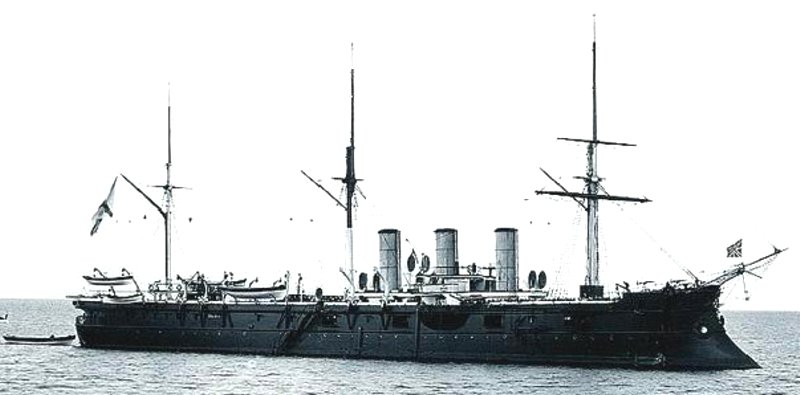
Pamiat Azova, date unknown – src: http://navalhistory.flixco.info
Development
The Pamiat Azova was the brainchild of vice-admiral Ivan Alexeyevich Tschastjakov. He was in 1885 in charge of the Russian Ministry of the Navy. To lead local fleet as a substitute of battleships, he projected an ocean cruiser with a displacement of 6000 t. The first drawings were completed in October 1885 by the Baltic plants in St. Petersburg, under the direction of engineer N. E. Titov. He designed a ship of 340 feet and 10 inches between parallels, and 377 feet and 4 inches at the waterline, with an estimated width of 50 feet and draft of 25 feet. As customary the new cruiser was mixed, fitted with full rigging in a barque style with three masts and a bowsprit.
On December 9, 1885 the shipbuilding department of the Navy Ministry specified on this design both the required armament and armor levels. A first it was chosen to give the new cruiser two 8 in guns /35 calibres, each weighting 2798 pounds or 47 tons as estimated since these guns were not forged yet. In addition, a secondary arament of fourteen 6-inch/35 caliber were chosen, each weighting 9,660 pounds. 8-in Ammunition alone, 1255 rounds, counted some additional 2,500 pound, and 8846 for the 6-in guns. Total weight combined reached 391 tons.
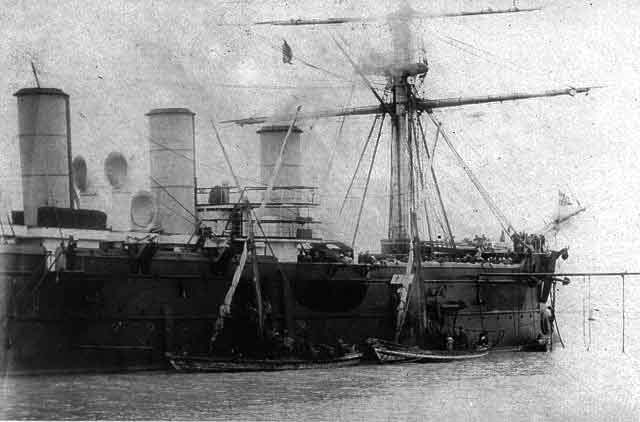
The Naval Technical Commission estimated the armor belt was to measure 179 feet long. It was to be completed by armored transverse bulkheads below the waterline, making an armored box of around 714 t. However by mid-February 1886, this scheme wasmodified as the belt armor was extended over the entire waterline and its vertical depht increased to 6 feet. The armor deck as designed was to be 37 mm thick, later reduced to 25.4 mm on both ends.
Construction
On June 27, 1886 at last, the ship was christened Pamyat Asova. Her keel was laid down at Baltic Works shipyards on July 12, 1886. The ceremony was attended by the Russian Emperor Alexander III, Empress Maria Fedorovna, Greek Queen Olga Konstantinovna and General Admiral Alexey Alexandrovich. Construction however really proceeded from 4 March 1886 with a construction technique tested on the cruisers Admiral Nachimov and Vladimir Monomakh by the shipyard.
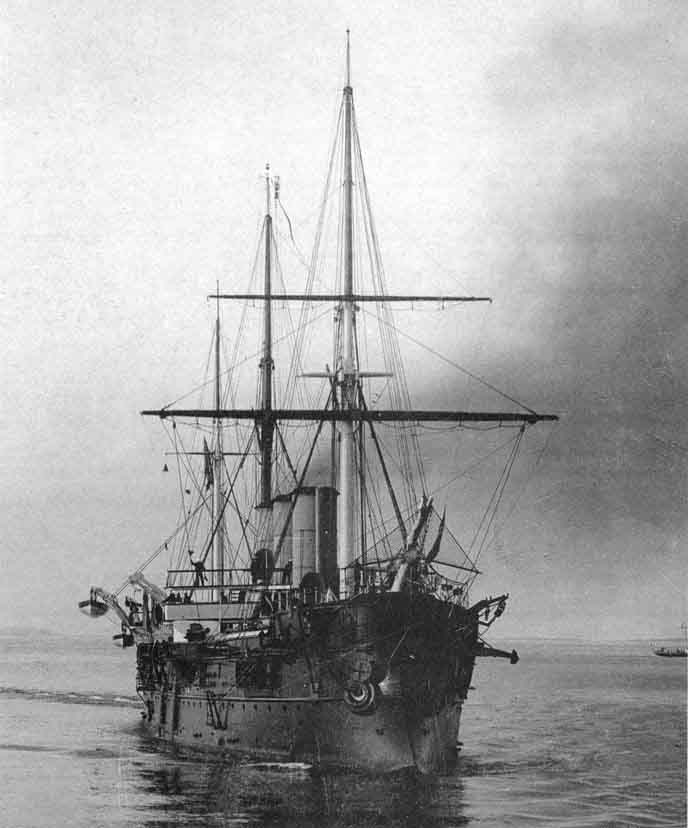
Launching ceremony and honorary assignments
Launching took place on 20 May 1888 also in the presence of the Russian Emperor Alexander III at the same place the first ship of Russian Emperor Peter the Great was launched 200 years prior. Meanwhile the crew was assembled, affected to Queen of Greece. This symbolic assignment of the queen is roughly equivalent to that of a regimental owner, honorary, widespread in European armies at the time. The ship was therefore “the Queen’s own Pamiat Azova”, explained by the fact the battle of Navarinon happened in Greek Waters.
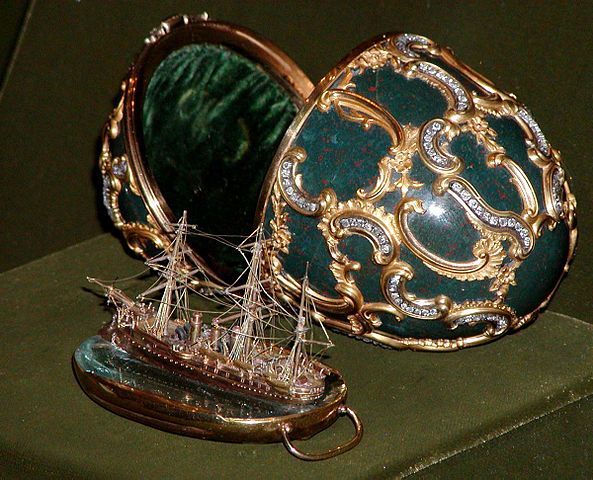
Fabergé Egg, preserved in St Petersburg
Partial conversion as Imperial Yacht
Collecting equipment had to be rushed as Tsarevich Nikolai Alexandrovich expressed the wish to carry out an educational trip onboard. Just in prevision of this trip, the officers-assigned interiors has been lavishly, luxuriously garnished with very expensive furniture and golden-plated mirror framing in mahogany, while even dinghies were gilded. Room and table service was also very expensive. The mian quarters on deck, cabins and wardroom were recovered by tiles and a split asphalt floor covering.
Additional weight resulted of these alteration reached 70 t. Also in the same tradition, two Fabergé Eggs, given later to the Tsar and his heir dedicated to the ship, a model made with gold and precious stones with Chinese silk sails was contained in it. It still exist today, in exhebition. Made by St. Petersburg jeweler Carl Peter Fabergé made these two Fabergé eggs during the trip, onboard the ship in her inaugural voyage.
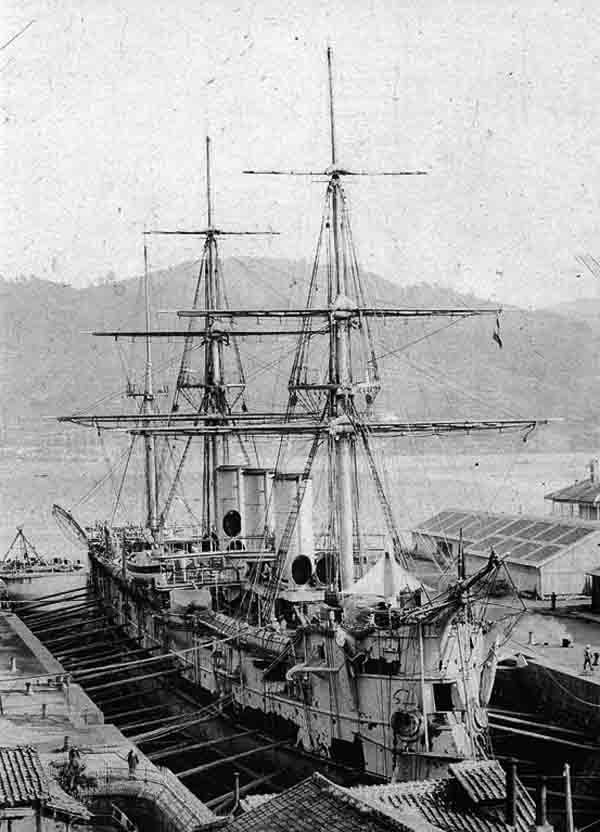
Pamyat Azowa in Nagasaki, showing the extreme growth of vegetation on her hull prior to new radical anti-fooling measures.
Design of the Pamiat Azova
Powerplant
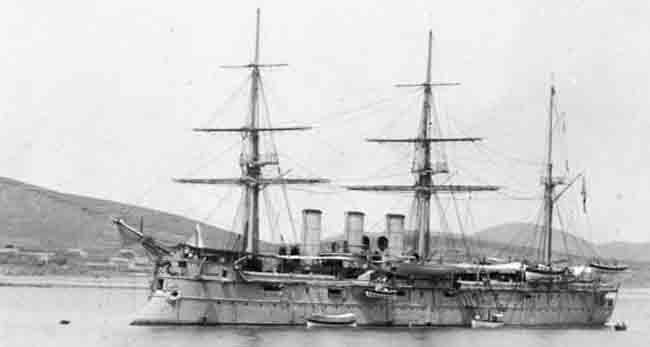
As built, the Azova was propelled by two shaft VTE steam engines and six cylindrical boilers rated for 8,500 ihp (6,300 kW). Tis allowed for a top speed of 17 knots. As refitted, she had two vertical triple expansion steam engines fed by 18 Belleville boilers rated for 5,664 ihp (4,224 kW) total, but apparently speed was kept to 17 knots (31 km/h).
Armament
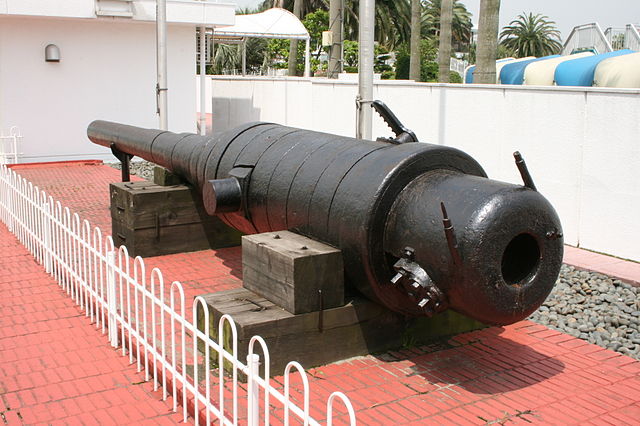
8-in M1885 pattern guns
The main guns were designed by Brink, the leading Russian artillery designer. Of 8” to British standard, about 203 mm and 35 caliber, they were brand new when the Azova was built, and was used on armored cruisers and Koreetz class gunboats of the 1880s. In addition to Azova, the Rurik and the Nakhimov adopted it.
It was a 35 caliber, breech-loading, pneumatically operated, comparable to modern Krupp and Armstrong standards. These guns weighted 13 tons (13.710 mt) each, with a 280 in (7.112 m) rifled barrel pierced by 48 grooves. They could fire HE & AP “Light” ammunitions, about 176 -198 lbs. (80 – 90 kg) each and HE & AP “Heavy” shells weighting 193 lbs. (133 kg). The propellant charge was 112 lbs. (51 kg) of brown powder, and muzzle velocity for the “Light” shells was 2175 fps (663 mps), or 1912 fps (583 mps) for the heavy ones. Range was 5,800 yards (5,310 m) at 6° with reasonable accuracy and up to 15°, 10,000 yards (9,150 m) was possible. They were posted in 21 tons single barbette mount in sponsons on the broadside, abaft the first and second funnel. The gun recoil was 38 in (96.5 cm) for open mounts.
The first of these 8-in pieces of artillery was made in 1886 and by 1887 a total of 29 were in order and gradually delivered to the various yards. They were removed in about 1904-05, as flagged obsolete but recycled by the Army as coastal defense guns, seeing World War I as well.
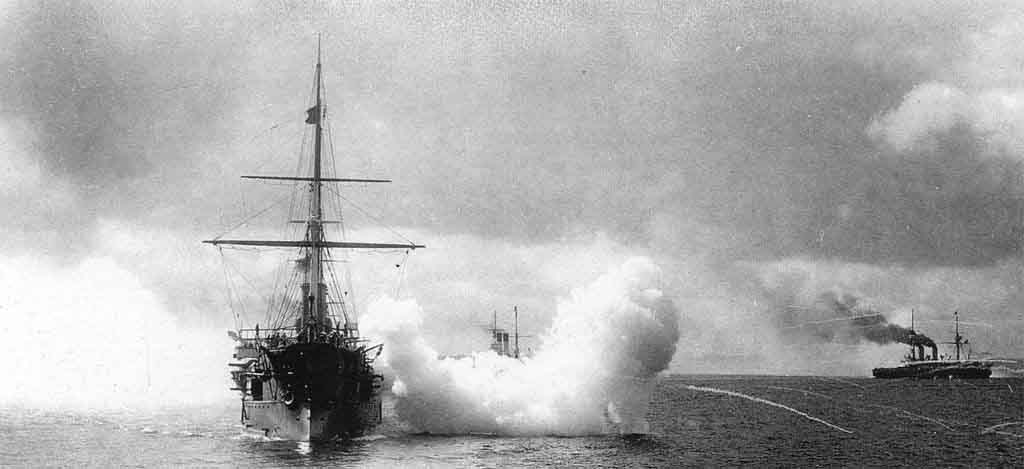
Pamiat Azova’s gunnery exercize with the Pacific fleet circa 1902
Secondary guns were of an apparently older design, the 6 inch 35 caliber naval gun 1877. Designed by Staff captain A.F. Brink it was to sustain 20% more barrel pressure. It proceeded from barrel material strength theories of lieutenant general N.V. Kalakutskij from the Obukhov State Plant, the Russian Imperial shell factory and main arsenal. Although patterned 1877, the gun was introduced as a 35 caliber gun in 1885. The internal tube was a five mantle barrels, shroud, connecting and mounting rings. The mechanical breechblock used a Treuille de Beaulieu screw system with de Bange obturator. The gun was widely used, and elevation varied after the mounts used, Vavasseur -7° to +20°, Dubrov -5° to +15°, or Krel -4° to +12°. Therefore Maximum firing range was about 15,000 m (16,000 yd). Rate of fire, theoretical, was about 4-5 rpm, but in practice around just one per minute. Muzzle velocity ranged from 600 to 700 m/s (2,000–2,300 ft/s) depending on ammunitions used, HE or AP, heavy or light types. On the Azova, these fourteen guns were mounted in the lower battery deck, behind walls, only partially protecting from shrapnells. One was located in the prow behind and enclosed two-door port, like the others, and two in recesses of the bow, pointing forward.
In parralel for the black sea ships was used another 6-in gun standard called 6″/35 (15.2 cm) Pattern 1877. Designed by Brink over a long period of time, based on Western standards, the first prototype was ready and tried in 1882. Probation and acceptance intervened later so it was manufactured from 1887. A 1885 British patent was purchased and later 5 rows of rings were attached along the barrel with ashroud, connecting ring and mounting ring. This helped to develop the 6″/45 (15.2 cm) Pattern 1892. In all cases, they were still in use in WW1, some in coastal batteries.
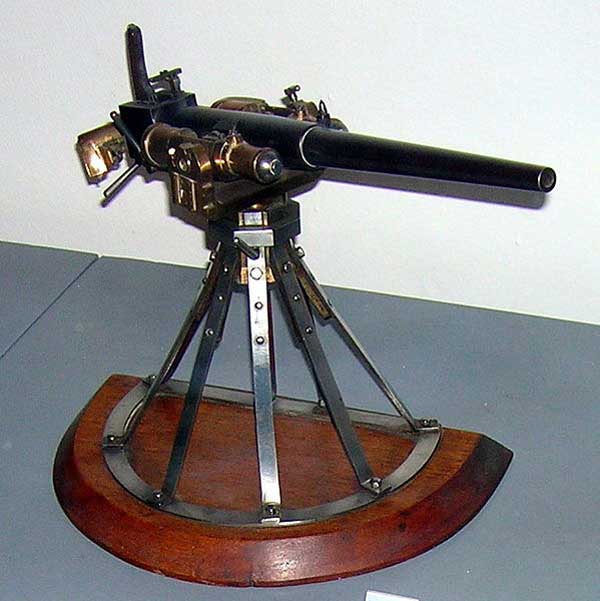
The tertiary armament comprised seven Hotchkiss 47 mm guns (3 pounder) and eight 37 mm guns (2 pounder). The first were of the very common and propular Hotchkiss QF design, built with a vertical sliding-wedge, capable of 30 rpm, with a muzzle velocity of 571 m/s (1,870 ft/s), and maximum firing range of 5.9 km (3.7 mi) at +20° and up to 4.5 km (2.8 mi) at +80°. They were placed on the upper deck behind walls, protected from shrapnells, along with the 37 mm guns. To close this off, the ships were also given three submerged 15 in (380 mm) torpedo tubes, one facing forward, the two others in the broadside.
Protection
Dispacing 6,674 t (6,569 long tons), the Russian Imperial cruiser was 384 ft 6 in (117.20 m) overall (to the tip of the ram), 56 ft 6 in (17.22 m) wide and for a 26 ft 10 in (8.18 m) draft. Her armour (It seems it was Krupp armor) comprised a belt 6–4 in thick (150–100 mm), running for the entire lenght and decreasing past the two main barbettes at the ends, a main armored deck 2.5 in (64 mm) thick above the waterline and Gun shields 2 in (51 mm) thick. The conning tower was 1.5 in (38 mm) in thickness. These figures are not very impressive, and the belt and armored transverse bulkheads below the waterline forming a box was the strongest part of the design. Since the rest was lightly protected the ship was a typical protected cruiser, not designed to fight armoured cruisers.

Painting from Alexander Karlovich Beggrov (1841-1914) showing the Russian fleet of 1883-1896 built in the Baltic Mechanical Plant, St. Petersburg by N.E. Titov.
Active service of Pamiat Azova
Maiden voyage across the globe
On August 23, 1890, the Pamiat Asova departed under command of her first Captain, 1st rank N. N. Lomen. The maiden voyage bring her across the Baltic and out into the North Sea, English Channel, and south in the Bay of Biscay. She then rounded the Iberian Peninsula and made it into the Mediterranean Sea through the Gibraltar strait. From there she crossed all the way east to the Dardanelles, and proceeded into the Black Sea where she joined Sevastopol, takin on the Prince. During the trip she experience her first storm around Plymouth and another off Malta. The captain commented he found the frigate quite strong, with good seaworthiness even fully loaded. However she was “too short” to cut large ocean waves.

Pamyat Azova in Malta, Valetta harbor
However when back through the Dardanelles, Turkey refused let the ship pass through. The heir to the throne had to join Trieste by land and on 19 October the ship left Trieste with the Prince onboard, bound Ceylon via the Suez Canal, Red Sea and across the Indian Ocean. She stopped in Bombay for a state visit of 42 days. However during this, the Prince’s own brother, Georgy Alexandrovich, an ensign on the Pamiat Asova, contracted tuberculosis and had to join on January 23, 1891 the cruiser Admiral Nachimov back to Russia. The Azova set sail on January 31, 1891 to Ceylon. From there she stopped at Singapore, Batavia, Bangkok, Saigon, Hong Kong and Nagasaki before making it to Vladivostok on 16 May. While in Japan, the press widely commented about the Ōtsu incident, after a Japanese policeman name Tsuda Sanzō attempted to shoot the heir to the throne. Emperor Meiji visited the ship a few days later as a good will gesture. But relations between the two empires were shaken for years, culminating in 1904.
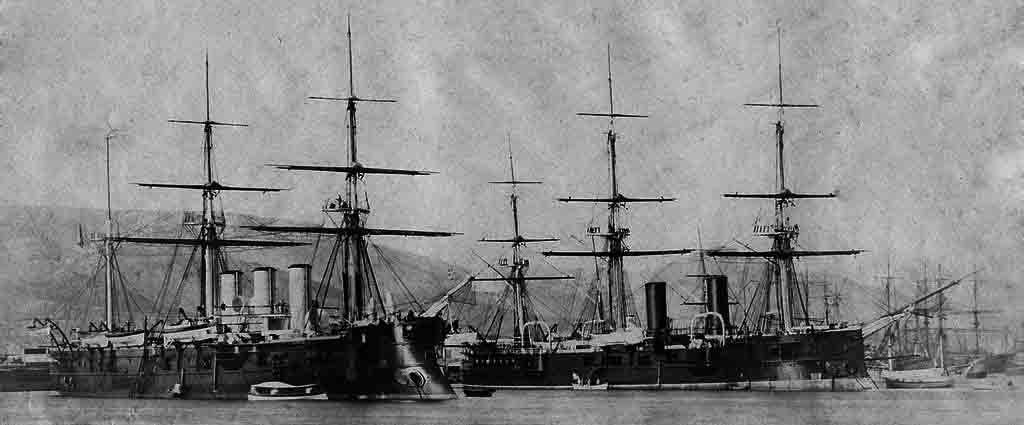
Azov and Monomakh in Piraeus harbor, Greece
While in Vladivostok, Captain 1st rank S.F. Bayer too command in turn as captain. In 1892, Pamiat Azova departed for Far Eastern waters. On May 5, 1892, she was back to Vladivostok, leaving command to captain 1st rank G. P. Chukhin. She departed back for Europe in the summer of 1892, arriving in October 1892, a two-year trip across the seas and oceans off the Russian continent.
Mediterranean
In the winter of 1892/93 work started to get rid of top overload, making the ship rolling badly since her commission. Howover if Tschuchnin’s asked to get rid also of the now obsolete rigging, thios was refused by the Naval Technical Commission. This will be done in the 1910s refit before the sip was renamed Dvina and convered as a school cruiser. On August 23, 1893 she sailed from Kronstadt to join the Russian Mediterranean squadron. In the fall of September however, the Cruiser Admiral Nakhimov, just arrived with the squadron with an unexperience crew for her maiden trip, rammed the Pamiat Asova when manoeuvering to take place at the end of anchor line. Promptly, skillful action of the cruiser’s crew reduced immediate damage and allowed later to repair it quickly.
The squadron was stationed by then in the Piraeus in Greece. The Greek Royalty paid a visit to the ship honorary to the Hellenic Queen and in celebrations of th Navarino victory over the Turks. Visits in Mediterranean ports succeeded each others and in between the crew proceeded to extensive combat training and fleet maneuvers. In the end of 1894, the Russian cruiser departed for the Indian Ocean.
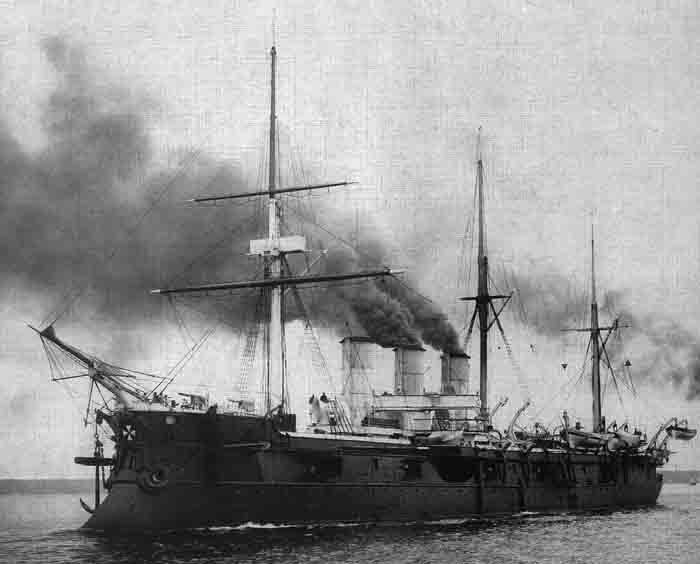
Azova steaming up in 1902
Asia
On November 22, 1894 she departed from Piraeus, celebrating the holiday of Saint George on 26 November at sea. On her way to the Pacific, she towed two newly built torpedo cruisers, Vsadnik and Gaidamak, intended for the Pacific fleet, due to their short range. She reached the port of Nagasaki on February 6, 1895, became flagship of the Pacific Squadron under Vice Admiral Pavel Petrovich Tyrtov during this stop. The squadron was then distributed along various Japanese ports, whereas in Nagasaki remained the cruiser, teaming up with Vladimir Monomach. Fall April 1895, the squadron moved to Zhifu in China amidts growing tensions between China and Japan, the squadron was made were ready for action.
The hull paint was changed from black to a more military very pale gray-pinkish hue (which looks white on photos). The ships’ commanders choosed himself the camouflage as the mos appropriate. This was completed by a pink-gray overcolor, merging with water at night, evening and noon, made more difficult to spot. By the time she still led the squadron, including the cruisers Admiral Kornilov and Rynda. However on May 13, 1895 she was hit by the TB Vsadnik which rammed her amidships. Copper fittings and wood planking below the waterline were damaged, but damaged was repaired in seventeen days, using also divers to access the damaged part. Eventually Japan gave up its claims over the Liaodong Peninsula, making the war threat averted. The Russian squadron therefore departed from China to Vladivostok, arriving on June 29.
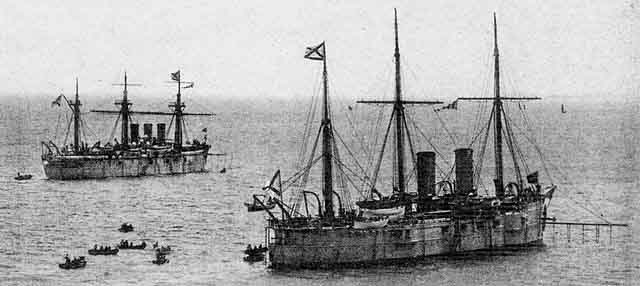
Vladimir Monomakh and Pamyat Azova in Zhifu, China, 1894
On November 20, 1896, Pamiat Azova was back in Nagasaki and later Vladivostock for two drydock sessions, anti-fooling operations and repairs. Fooling was performed for the first tile in years and has been so bad she lost two knots in top speed. However technicians and experts were baffled by the extent of the vegetation growth underbelly which had never testified previously of suchextent and speed. Copper plating was added and bronze such adopted for the blades bearings, stern tubes, and propellers among others. She was relaunched and on 20 September 1897, welcoming Emperor Nikolai II , which examined the underwater fooling while in dry dock in Vladivostok. It showed that the vegetation was less strong and unevenly distributed. Copper fittings placed in Nagasaki were seen as free of fouling. The new sip captain 1st rank A. A. Virenius proposed a new chemical composition for the anti-fooling paint, getting rid of costly copper sheets. Inded in addition, these tile’s edges became thin and brittle.
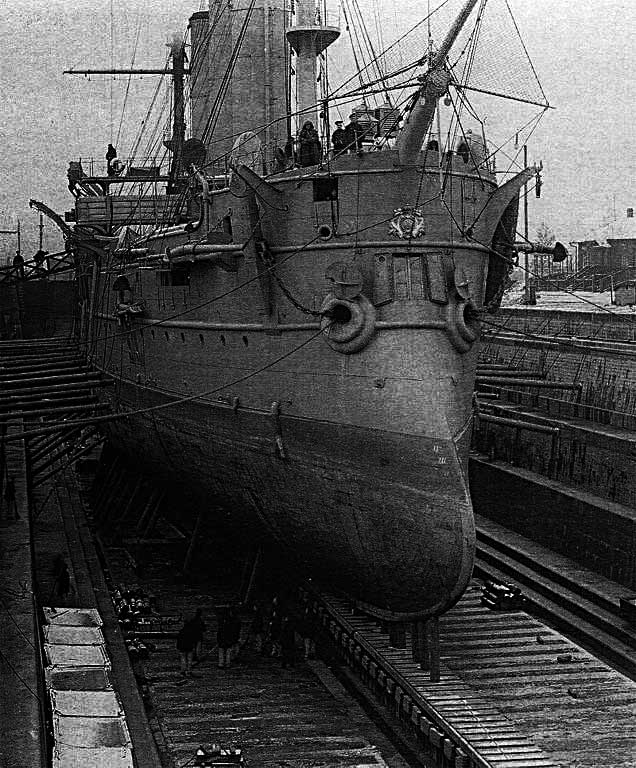
Dvina (Former Pamiat Azova in drydock for conversion)
In April 1898, this time with the consent of the Pacific Squadron commander, masts were mofified. Pamiat Asova was transferred to Port Arthur. Grand Duke Kirill Vladimirovich hoisted hos personal flag showing the St. Andrew’s Cross on the cruiser which remained until spring and summer, moving to other ports.
By the fall of 1899, Pacific Sqn received battleships in exchange and Pamiat Asova left Vladivostok for Kronstadt, that she reached the spring of the following year. Until 1900 she formed the experienced core of the Pacific Squadron.
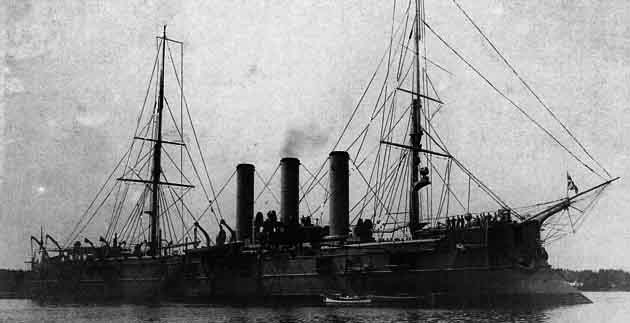
Baltic Sea
Pamiat Azova was ageing at the beginning of the new century, but was still indispensable to the Russian fleet. In 1900 she went into drydock for a first major refit: Her armament was completely modernized. Her centralized, onsolete pump system was improved and expanded. She was back from ths yard in the summer of 1901, as flagship of the Naval artillery training unit. She started her second career as a schoolship, at first as a peacetime duty.
When the Russo-Japanese War broke off, Pamiat Azova was just assigned to the 3rd Pacific Squadron, but at that time, it was juged her oveall age and technical conditions forbid a transfer. So in pat luckily she missed the war, and probably her doom. In 1904, the cruiser underwent another set of modifications, this time in the Franco-Russian works shipyard in St. Petersburg. Boilers were replaced again by brand new oil-fired French Belville VTE. The three masts were at last removed, two new military masts fitted instead with telegraphiy and rails along the decks and equipments for laying mines. Work was completed in 1906, and then she was assigned to the mine training unit.
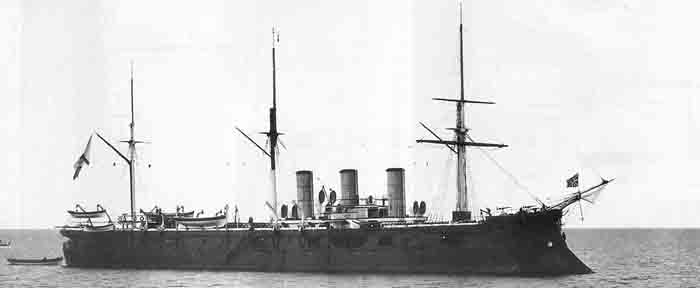
Pamiat Azova in 1902
Mutiny
In 1906, Pamiat Asova was the flagship of the artillery training unit, under command of captain 1st rank H.D. Dabitscha. Die to the frequent crew turover, revolutionary mood diffused gradually on board, and a part of the old permanent crew started political agitation, distributing tracts and making proclamations from the Russian Social Democratic Party (RSDP). On July 19, off Papownik near Reval, Arsenii Koptjuch, disguised as a sailor coming from the torpedo cruiser Arbek clibed unnoticed onto the ship and around 11 o’clock, during the dead of the night, held a clandestine meeting with the crew’s revolutionary committee, joined by about 50 lower rank officers and sailors.
The committee learned by telegram the uprising in Sveaborg fortess and debated whether to join it. At 2 AM, the officer on watch was at last informed of the meeting, warned officers which promptly arrested Koptjuch. The latter behaved uncooperatively however, and tension rose with the commander, which ordered to remove his rank insignia and cap, transferring him on the torpedo cruiser Vojevoda, leaving for Reval.
Quartermaster Lobadin, however, was part of the mutineers and opened the weaponry to the crew. By 3.40 AM the first shot was fired on the upper deck, killing the watch officer and wounding badly another staff office. On behalf of the commander retained below deck, two officers reached with their own arms the upper deck. One was shot dead, while the other seeing no escape jumped into the sea but shot dead by the mutineers while attempting to swim away. Hatchways to the lower deck were opened, and more shots through the openings, killed the ship’s surgeon, and wounding the commander, killing also the oldest ensign and senior mechanic, in his cabin.
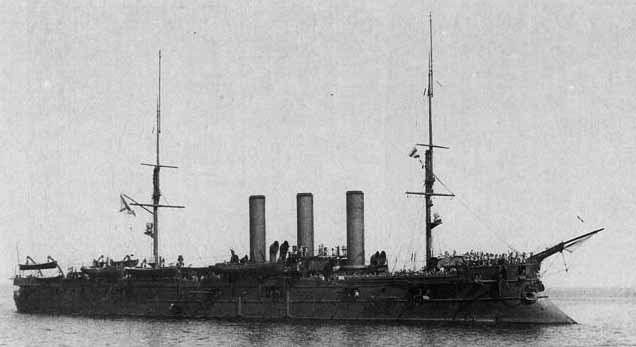
Pamiat Azova in 1906
The commander and upper officers managed to escape via the steam launch, while the others remained on the ship, devising a way to tackle the mutiny. Mutineers however were on the hunt. When they spotted the Commander’s escaping, they had a steam cutter disambarked at sea, with a 37 mm cannon. They hit the commander’s boat twenty times, killing the commander and a midshipman and injuring the remnant of the officers. The mutineers however ran aground and had to return to the cruiser, laying siege to the barricaded officer’s mess. They tried to throw inside incendiary bottles, but fire was mastered each time. At 4:30 AM, the door was broken open and officers arrested and locked up in their own cabins under heavy guard.
Koptjuchs was reinstated as the committee head, while the quartermaster Lobadin was chosen as ne captain. After breakfast, the anchor was lifted up while a signal was sent to other ships in the harbor, ordering them to follow the lead of Pamiat Asova. The torpedo cruisers Abrek and Vojevoda and the minelayer Retivy however refused to join the mutiny. Lobadin ordered to train starboard guns on them but the crews refused to open fire on their comrades, even loyal to the regime. Lobadin and his close followers then proceeded to fire, but failed. Since there was nothing more to do, the Russian Imperial Cruiser now in the hands of mutineers reached open sea, setting course for Reval.
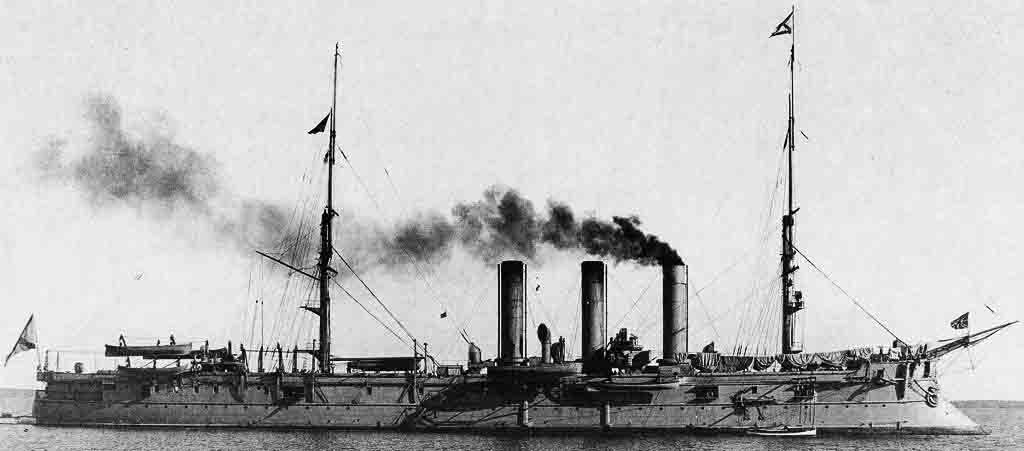
Dvina in Reval
At 5 PM, she anchored at Reval, but already the mutineers enthusiasm began to fade away. A corporal was killed by trying to bring some discipline, conducting Lobadin to order a mas shooting of all remaining officers. But the latter miraculously persuaded the crew not to and instead persuaded them the mutiny should be over and to arrest the leaders. Released, declared the uprising over and soon some mutineers were rounded by the crew remained loyal and shot, some jumping overboard. Other mutineers left in the ship surrended, were disarmed and detained ashore.
91 of them and NCOs, plus four civilians would court-martialed in a trial which started on July 31, until August 4. Koptjuch, which had survived the shooting, and seventeen mutineers were sentenced to death by hanging, another twelve to forced labor, thirteen to prison battalions, and fifteen received a disciplinary blame, but 34 sailors were acquitted. Hanging was converted later to a firing squad sentence, carried out on 5 August. Like for the Potemkine, the admiralty decided the affair was grave enough to have the ship renamed Dvina, on February 12, 1909. The honorary St. George’s flag and all assoiated regalia with the former ship were withdrawn. The ship was also degraded to full time schoolship and the armament removed at the exception of four 47 mm guns. Oil supply was reduced to 650 tonnes to prevent the ship for departing again.

The Dvina in WW1
By the fall of 1915, Dvina became a floating base for British submarines operating in the Baltic Sea. Storage rooms for spare parts and torpedoes were installed as well as accommodation for all submarine crews and the reduced Russian support staff. On March 31, 1917, while revolution was ongoing and under pressure from the revolutionary committee, the Department of Navy issued an order to return the previous names of Ships implicated in prior mutinies. Therefore, the ship was renamed Pamiat Asova again. By the spring of 1918, the British were about the leave the harbor and blew up their submarines to prevent capture. The Baltic Fleet was by immobilized by ice and Pamiat Azova became a flagship on May 6 as provlaimed at Helsingfors, she was laid ashore in Kronstadt and preserved. On the night of 18 August 1919 however, the British troops orchestrated a bombing of all warships of the Baltic Fleet. Six torpedo boats entered Kronstadt Bay, backed by an aircraft attack.
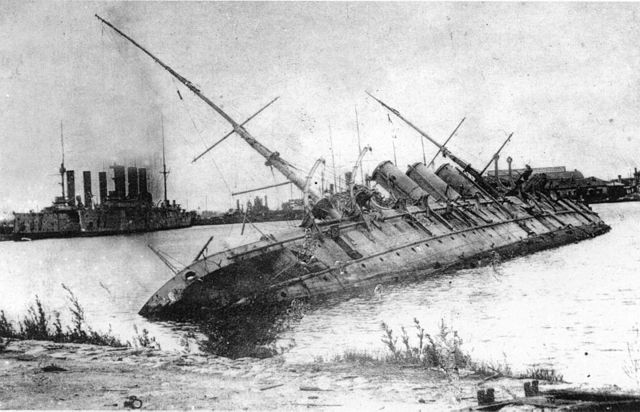
Pamiat Azova located at the entrance of the Bay was the first hit on her broadside. The two torpedoes opened a large gap into the hull, which filled quickly, listing at 60° to starboard. Eventually the ship’s other side met the bottom and she stayed there. For the next six years she remained as such, before salvage operations commenced in 1921, to be painfully completed by December 1923. Only by November 16, 1924, she was towed in a Kronstadt dock, and from April 16, 1925, not yet discarded, she was used as a provisional warehouse. One the 25 she was officially removed from the lists, this time by the Red Workers and Peasant’s fleet. She was broken up from 1927 to 1929, one of the rare ship from the 1880s surviving that far.
Author’s Illus:
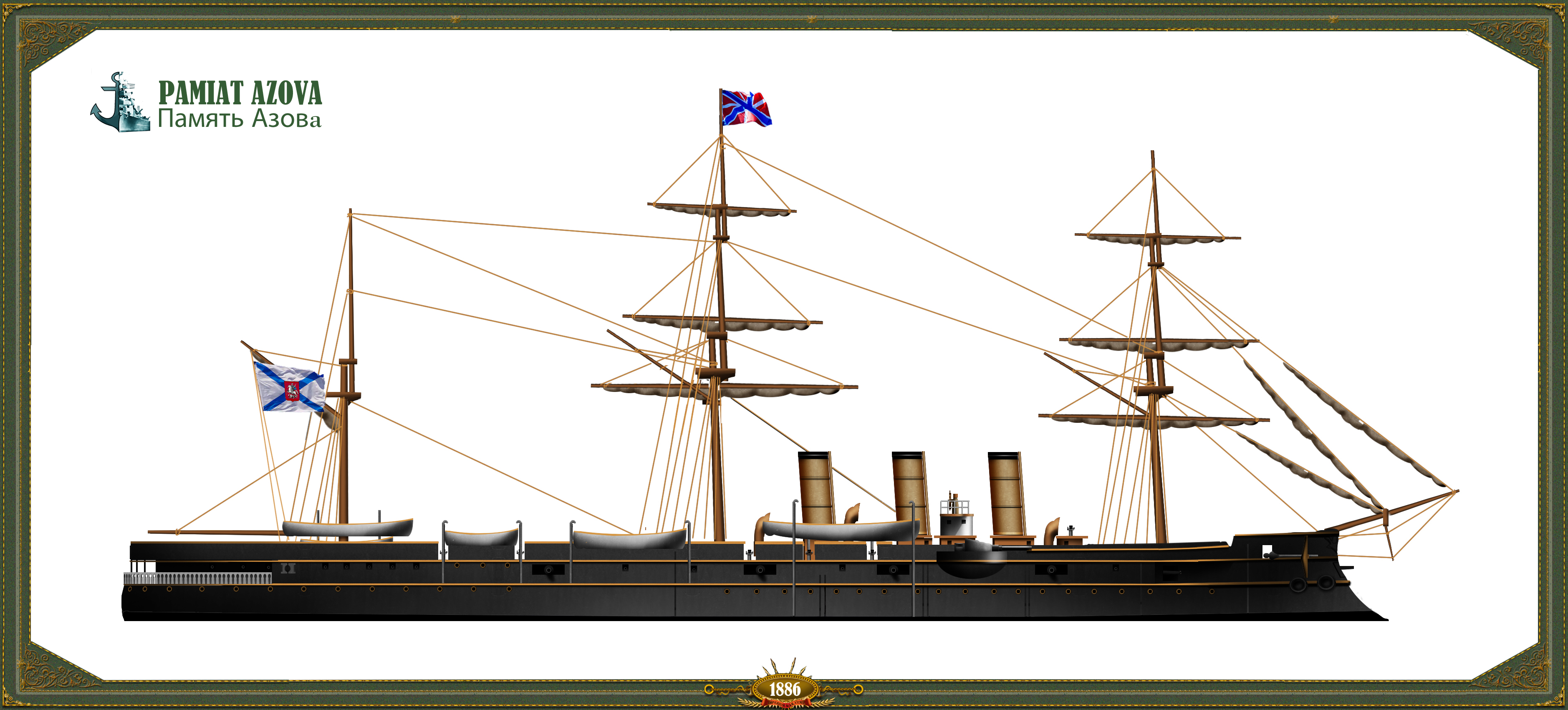
Pamiat Azova during her inaugural trip from the baltic to the pacific, black hull and full rigging in 1892-93.
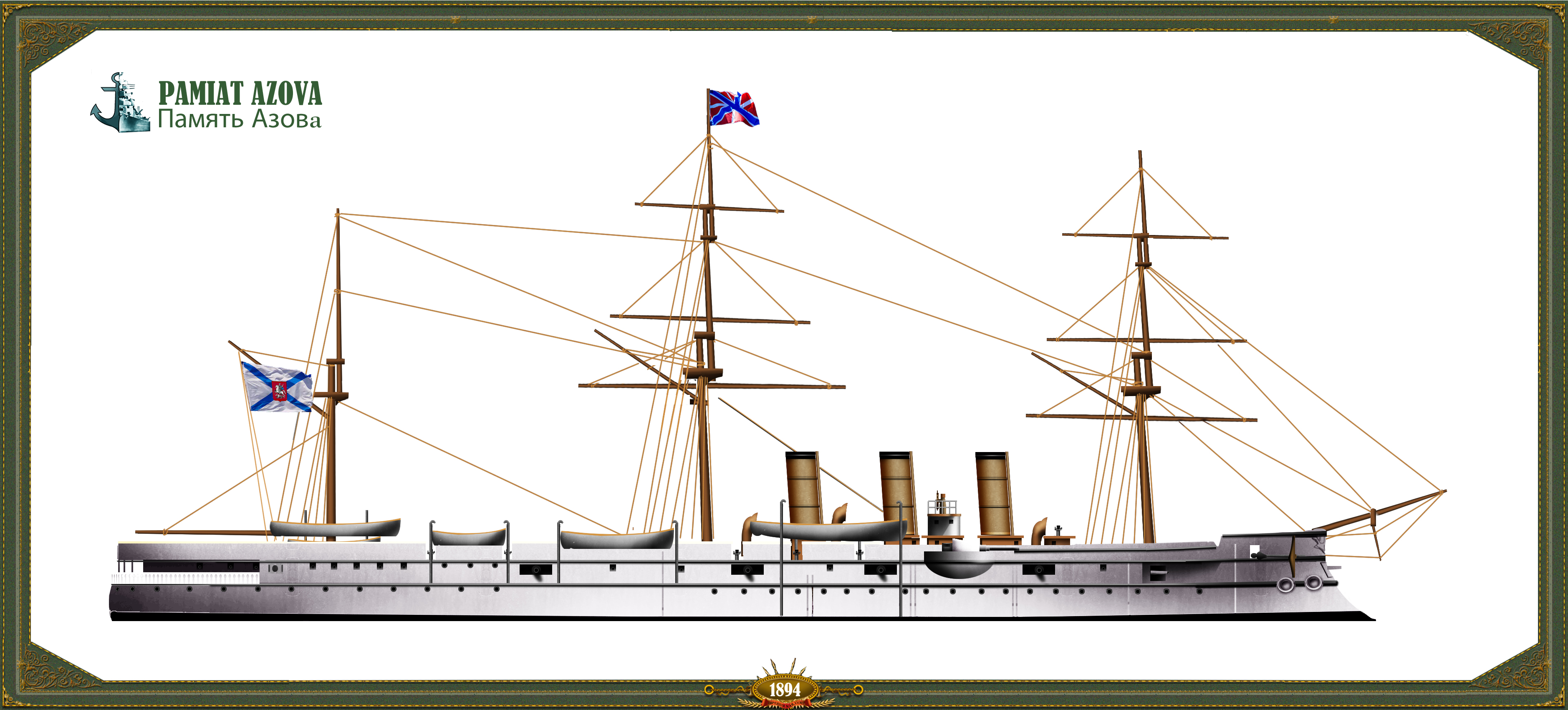
The cruiser at the time of the 1st Sino-Japanese war in 1894. She has been repained with a pale light blue.
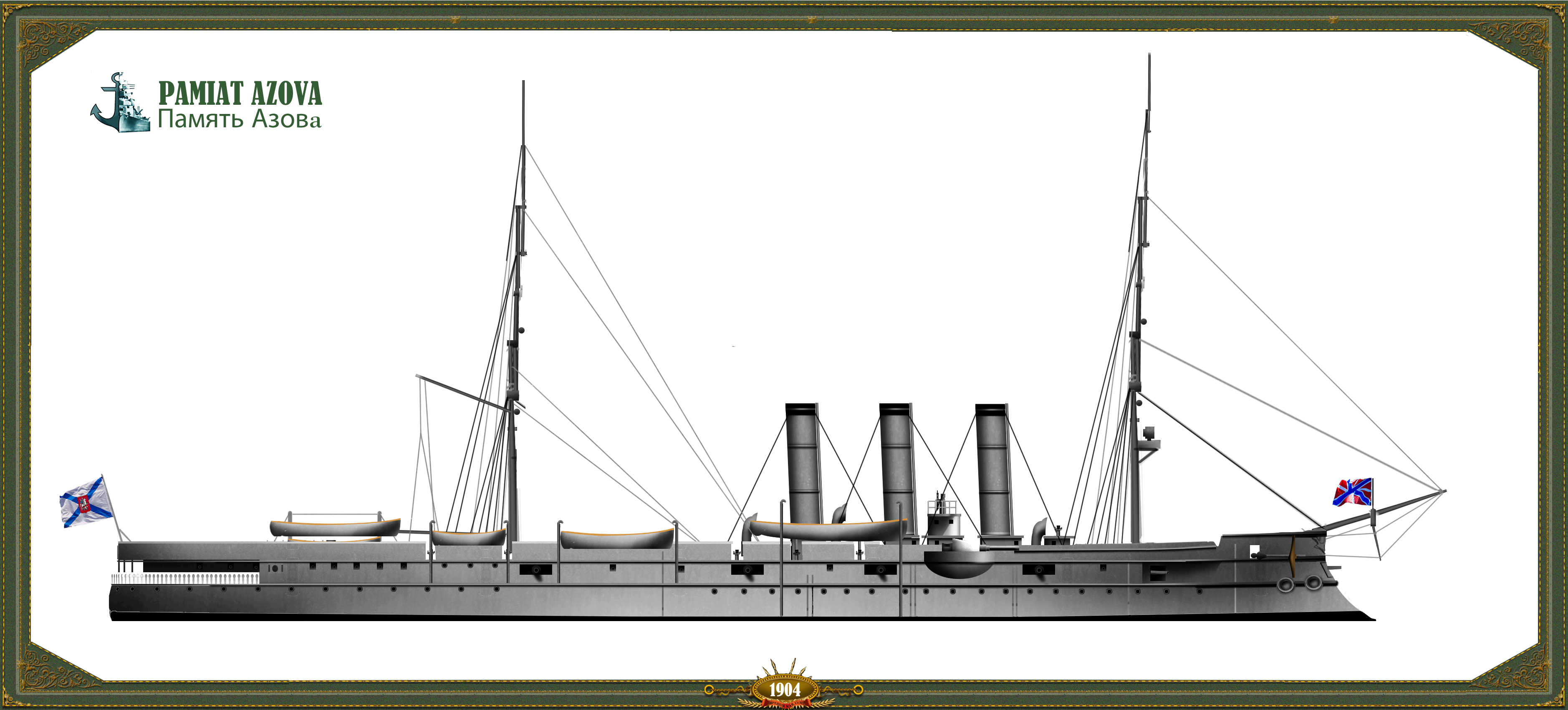
As the schoolship Dvina, later Azova in 1914. She received a medium grey livery, alongside partrial disarmament and many other modifications like the new military rigging.
Read More/Src
Conway’s all the worlds fighting ships 1860-1905
On wikimedia Germany (The most exhaustive source)
On wikimedia Japan (photos and additional infos)
http://nineteenkeys.blogspot.com/2009/05/pamyat-azova-and-rotten-egg.html
“Entsiklopedia Otechestvennoi Artillerii” (Encyclopedia of Fatherland [Russian] Artillery) by A.V. Shirokorad
http://www.shipmodell.com/index_files/0PLAN5C.html
https://temnikoffv.wixsite.com/museum-of-baltic-sea/pamiat-azova
http://www.navweaps.com/Weapons/WNRussian_Main.php


 Latest Facebook Entry -
Latest Facebook Entry -  X(Tweeter) Naval Encyclopedia's deck archive
X(Tweeter) Naval Encyclopedia's deck archive Instagram (@navalencyc)
Instagram (@navalencyc)





 French Navy
French Navy Royal Navy
Royal Navy Russian Navy
Russian Navy Armada Espanola
Armada Espanola Austrian Navy
Austrian Navy K.u.K. Kriegsmarine
K.u.K. Kriegsmarine Dansk Marine
Dansk Marine Nautiko Hellenon
Nautiko Hellenon Koninklije Marine 1870
Koninklije Marine 1870 Marinha do Brasil
Marinha do Brasil Osmanlı Donanması
Osmanlı Donanması Marina Do Peru
Marina Do Peru Marinha do Portugal
Marinha do Portugal Regia Marina 1870
Regia Marina 1870 Nihhon Kaigun 1870
Nihhon Kaigun 1870 Preußische Marine 1870
Preußische Marine 1870 Russkiy Flot 1870
Russkiy Flot 1870 Svenska marinen
Svenska marinen Søværnet
Søværnet Union Navy
Union Navy Confederate Navy
Confederate Navy Armada de Argentina
Armada de Argentina Imperial Chinese Navy
Imperial Chinese Navy Marinha do Portugal
Marinha do Portugal Mexico
Mexico Kaiserliche Marine
Kaiserliche Marine 1898 US Navy
1898 US Navy Sovietskiy Flot
Sovietskiy Flot Royal Canadian Navy
Royal Canadian Navy Royal Australian Navy
Royal Australian Navy RNZN Fleet
RNZN Fleet Chinese Navy 1937
Chinese Navy 1937 Kriegsmarine
Kriegsmarine Chilean Navy
Chilean Navy Danish Navy
Danish Navy Finnish Navy
Finnish Navy Hellenic Navy
Hellenic Navy Polish Navy
Polish Navy Romanian Navy
Romanian Navy Turkish Navy
Turkish Navy Royal Yugoslav Navy
Royal Yugoslav Navy Royal Thai Navy
Royal Thai Navy Minor Navies
Minor Navies Albania
Albania Austria
Austria Belgium
Belgium Columbia
Columbia Costa Rica
Costa Rica Cuba
Cuba Czechoslovakia
Czechoslovakia Dominican Republic
Dominican Republic Haiti
Haiti Hungary
Hungary Honduras
Honduras Estonia
Estonia Iceland
Iceland Eire
Eire Equador
Equador Iran
Iran Iraq
Iraq Latvia
Latvia Liberia
Liberia Lithuania
Lithuania Mandchukuo
Mandchukuo Morocco
Morocco Nicaragua
Nicaragua Persia
Persia San Salvador
San Salvador Sarawak
Sarawak Uruguay
Uruguay Venezuela
Venezuela Zanzibar
Zanzibar Warsaw Pact Navies
Warsaw Pact Navies Bulgaria
Bulgaria Hungary
Hungary

 Bundesmarine
Bundesmarine Dutch Navy
Dutch Navy Hellenic Navy
Hellenic Navy Marina Militare
Marina Militare Yugoslav Navy
Yugoslav Navy Chinese Navy
Chinese Navy Indian Navy
Indian Navy Indonesian Navy
Indonesian Navy JMSDF
JMSDF North Korean Navy
North Korean Navy Pakistani Navy
Pakistani Navy Philippines Navy
Philippines Navy ROKN
ROKN Rep. of Singapore Navy
Rep. of Singapore Navy Taiwanese Navy
Taiwanese Navy IDF Navy
IDF Navy Saudi Navy
Saudi Navy Royal New Zealand Navy
Royal New Zealand Navy Egyptian Navy
Egyptian Navy South African Navy
South African Navy






























 Ukrainian Navy
Ukrainian Navy dbodesign
dbodesign